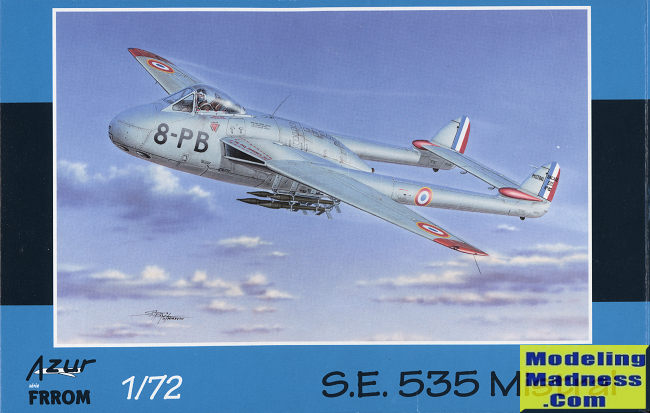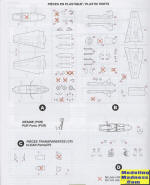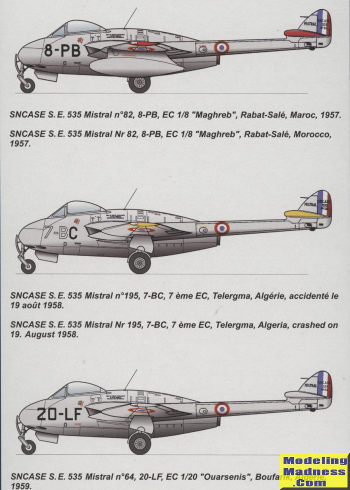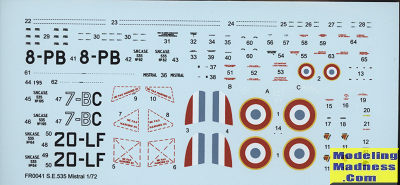
Azur/FRROM 1/72 S.E. 535 'Mistral'
| KIT #: | FR0041 |
| PRICE: | $ |
| DECALS: | Three options |
| REVIEWER: | Scott Van Aken |
| NOTES: | Includes resin ejection seat. |

| HISTORY |
| THE KIT |
 As
is often the case when there is a French derivative of a Special Hobby kit, that
variant is placed under the Azur (now Azur/FRROM) label. Such is the case with
this particular kit. The majority of sprues are dedicated to the standard
Vampire with an additional sprue containing those parts specific to the Mistral.
As the standard Vampire did not have a bang seat, the seat for the Mistral is
provided in resin, which is a big plus thanks to all the detail on it.
As
is often the case when there is a French derivative of a Special Hobby kit, that
variant is placed under the Azur (now Azur/FRROM) label. Such is the case with
this particular kit. The majority of sprues are dedicated to the standard
Vampire with an additional sprue containing those parts specific to the Mistral.
As the standard Vampire did not have a bang seat, the seat for the Mistral is
provided in resin, which is a big plus thanks to all the detail on it.
The Vampire/Mistral is not a complex aircraft and this kit shows that. The cockpit has a new seat, back bulkhead and instrument panel produced just for the French version. The cockpit section, nose gear well and the engine face and exhaust are installed in the lower fuselage half. There is no indication of nose weight required, but you will need all you can pack in front of the main gear attachment points.
There is a new upper fuselage section included as the Nene was
a larger engine than the Goblin. A new nose section is also included. When
building up the wings, you will be provided with new intake parts. While the
Vampire intake section is a single piece, each side for the Mistral is three pa rts.
The rest of the airframe is standard stuff. The two boom assemblies slot into
the back of the wings, trapping the horizontal stabilizer between them. Landing
gear are very nicely done and the outer main gear doors have retraction
mechanisms included.
rts.
The rest of the airframe is standard stuff. The two boom assemblies slot into
the back of the wings, trapping the horizontal stabilizer between them. Landing
gear are very nicely done and the outer main gear doors have retraction
mechanisms included.
A separate windscreen and canopy are provided with the canopy
able to be posed open. For things under wings you have a pair of large fuel
tanks and you can install four rockets (two on each side) on the inner wing
sections. 
Instructions are very well done with Gunze paint references. All three options are painted in high speed silver (not bare metal as these airframes were mostly wood). Markings are provided for three aircraft. One with the red bits is from EC 1/8 in Morocco during 1957. The EC 7 plane with the yellow bits was based in Algeria in 1958, while the unadorned EC 1/20 aircraft was in Algeria during 1959. I believe EC 20 was the training unit. A full stencil suite is also included and the instructions provide a nice placement guide.
| CONCLUSIONS |
It is nice to see this kit on the market as the last Mistral in this scale was the ancient Heller offering from the 1970s. To me this is welcome as I recently finished reading a nice book on the French Air Force in North Africa that has a lot of photos of these planes.
| REFERENCES |
https://en.wikipedia.org/wiki/De_Havilland_Vampire
April 2025 Copyright ModelingMadness.com. All rights
reserved. No reproduction in any form without express permission from the editor. Thanks to Azur/FRROM for the preview kit. This should be
available from various sources. If you would like your product reviewed fairly and fairly quickly, please
contact
the editor or see other details in the
Note to
Contributors. Back to the Main Page
Back to the Review
Index Page
Back to the Previews Index Page